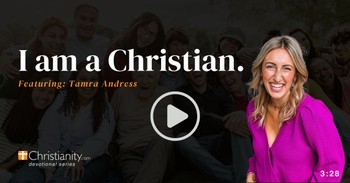No other place in history commands such reverence and fear as the Holy of Holies because it was the most sacred place on earth. We usually equate the Holy of Holies as being within the wilderness (Exodus) tabernacle after the Lord God delivered the Hebrews from the Egyptians (Exodus 25-40), and later in the temple built by King Solomon (1 Kings 5-8; 2 Chronicles 2-7). In this article, we’ll discover where God first placed the Holy of Holies and how, within God’s glorious plan of redemption, the Holy of Holies forms the bookends of redemptive history found in the Bible, from Genesis to Revelation.
What Was the Holy of Holies in the Old Testament?
The Holy of Holies represented God’s presence on earth. In the Old Testament, God commanded and blueprinted the Holy of Holies to be part of the Exodus tabernacle (Exodus 25-40), and later in Solomon’s Jerusalem temple (1 Kings 5-8; 2 Chronicles 2-7).
Both the tabernacle and temple served to host God’s presence among His people for worship and sacrifice, and the Holy of Holies was where God manifested His presence. Looking back to the beginning, God’s creation is the first tabernacle/temple where He chose to be close to His people and enjoy their worship and sacrifice (Psalm 78:60). He is everywhere among His creation, and Genesis 1:1 forms the first bookend of the Bible. Creation is likened to a tabernacle, the place where God and His glory dwells with humanity. He formed all of His creation to be His immeasurable temple (Psalm 19:1-2; 98:8).
We also see the image of the tabernacle in Eden. As alluded to in the introduction, the location of the first Holy of Holies was the Garden of Eden, where God placed the first man (Genesis 2:8). We can look at the Garden from outside in as a type of the tabernacle (Ezekiel 28:13-14, 16, 18). The outer court is the land outside the land of Eden. Eden was the inner court (holy place), and the garden was the Holy of Holies, where God dwelt among His first created humans.
As the topic of the temple unfolds in the Old Testament, we begin to clearly see that God Himself was the Builder and Designer of the first temple as described in the beginning of Genesis. The first four chapters of Genesis provide striking parallels to the temple/tabernacle, such as:
- The presence of gold and precious stones (Genesis 2:11-12).
- Arboreal paradise (Genesis 2:9), reminiscent of the golden lampstand (Exodus) and Solomon’s Temple (1 Kings 6)
- A river flowing east which provided water to the garden and the surrounding lands (Genesis 2:10) just like Ezekiel’s vision of the temple (Ezekiel 47:1)
- God’s presence in the Garden (Genesis 3:8) just like the Holy of Holies in the tabernacle/temple.
- Cherubim guarding entry to the Garden of Eden and the Tree of Life, just as Cherubim “guarded” the Holy of Holies in the tabernacle/temple (Genesis 3:24)
- Just like in the tabernacle, in Genesis there is a three-fold division which progresses eastward (Genesis 3:24; 4:16).
These initial elements introduced in Genesis help inform the later developments of the temple described throughout Scripture. When the Lord God instructed Moses in the plan and construction of the wilderness tabernacle, and later, King Solomon’s temple, the layout of each was the same, even though Solomon’s temple was more permanent. The Holy of Holies was built as a perfect cube—twenty cubits long, twenty cubits high, and twenty cubits deep (1 Kings 6:20).
To enter the Holy of Holies, the priest (a different priest only once per year) passed through a curtain to enter into God’s presence—to come before His throne.
Within the hallowed Holy of Holies sat the most sacred item in the tabernacle: the ark of the covenant.
The elements of the Holy of Holies (Exodus 26:31-34; 40:1-33) included:
- The veil of blue, purple, and scarlet material, and fine twisted linen. This veil separated the inner court from the Holy of Holies, and only the selected priest for that year’s Day of Atonement could pass through the veil into the sacred place. Images of cherubim were embroidered upon it and it was hung on four pillars of acacia wood overlaid with gold (only the finest metals and materials were used for the Holy of Holies). The gold hooks for hanging the veil were on four silver bases. The colors used in the veil were also symbolic; purple is equated with royalty, blue with divinity, and red with blood and sacrifice, which points to Christ and His ultimate atonement for us.
- The images of the cherubim symbolized those the Lord placed as sentries guarding the way back into Eden and the tree of life after the fall of humankind (Genesis 3, esp. v. 24).
- The gold encased ark of the testimony (covenant) was the most important item in the whole tabernacle, and it held a golden jar holding the manna, Aaron’s rod which budded (Exodus 16:33; Numbers 17:1-11), and the tablets of the covenant (Exodus 25:16, 21-22; Hebrews 9:3-4).
- The golden mercy seat (atonement lid) sat atop the ark and was one piece with the golden figures of the cherubim which overshadowed the whole mercy seat (Psalm 80:1; 99:1). This is considered the throne of God (Exodus 25:22), and from here He rendered His judgment on the priest and the people. The mercy seat and the ark of the covenant are God’s footstool and throne (1 Chronicles 28:2).
Here we see the seed of the ultimate tabernacle and Holy of Holies. The tabernacle points back to creation and forward to the new creation in Christ (Revelation 21:5).
Why Was the Holy of Holies So Sacred?
The Holy of Holies was where God manifested His presence on earth; that is why it was the most holy place.
Yet this sacred place was and is part of God’s plan from the beginning to dwell with us and be our God—to give those He’s called full access to Himself (Leviticus 11:44; 1 Peter 1:16). Our communion with God takes place in His presence, so our communion centers around the Holy of Holies, which is where God dwells among us. That is why—for a time—worship was confined to the specified location of the temple/tabernacle. That was where the Holy of Holies was, and everything else in the temple revolved around communion and service before God’s presence.
What Happened Behind the Veil Each Year?
Each year’s appointed priest would present sacrifices to the Lord on the Day of Atonement to atone for his and the peoples’ sins (Leviticus 16:1-3, 30, 34). He would enter the Holy of Holies three times:
(1) to place a firepan of burning coals with incense to veil the area with smoke (Leviticus 16:12-13),
(2) to sprinkle the blood of a sacrificed bull with his finger on the east side and seven times in front of the mercy seat (Leviticus 16:14),
(3) to sprinkle the blood of a goat as he did the bull’s blood (Leviticus 16:15).
Israel was in a hopeless state (Leviticus 16:16), and God judged both the high priest and all of Israel. In His mercy, however, on that day, the blood of sacrifice atoned for their sins and reached all the way to God’s heavenly throne. He would descend and meet with the anointed priests to accept the atonement for the peoples’ sins until the following year, when once again the appointed priest would go behind the veil with the sacrifices for the continued sins of the people.
How Does the Holy of Holies Point to Christ?
The Tabernacle itself was fulfilled in Christ, who came in the fullness of time to tabernacle (dwell) with and redeem mankind (John 1:14; Galatians 4:4-5). Jesus dwells with us (through the Holy Spirit) during our exodus on earth (Matthew 28:20; 1 Peter 2:4-5, 11).
- Lampstand (of Testimony): (John 8: 12-18; Revelation 1:12-16). Jesus is the Light of the Lampstand.
- The Ark of the Testimony (1 John 5:11-12). The elements placed in the ark parallel Who Jesus is, the Testimony.
- He is King (the stone tablets on which are engraved the Ten Commandments).
- Jesus is Deliverer (Aaron’s budded rod).
- He is Provider (the jar of manna).
- Jesus is the High Priest who “appeared once for all at the end of the ages to put away sin by the sacrifice of Himself (Hebrews 9:26, cf. Hebrews 2:17; 7:26; 9:7, 11, 25).
- Jesus is the Passover Lamb (Matthew 26:26-28). He is the perfect and final atonement for the sins of the world.
- Jesus is the Mercy Seat (Literally Propitiatory Seat) – On the Day of Atonement, the blood of the Lamb was sprinkled on the Propitiatory Seat, removing God’s wrath from the people. Jesus is our Propitiation, removing God’s wrath from us through His sacrifice.
- Priestly Garments: Just as priests were able to minister in God’s presence only with the garments he provided, we are able to minister in God’s presence because we are clothed with His righteousness (Exodus 28:3; 2 Corinthians 5:21; Ephesians 4:24).
- The Altar: We can offer worship and praise to God only through Christ because He sanctifies our worship (Romans 12:1; Hebrews 13:10-12).
On the cross, when Jesus cried out His last and yielded up His spirit, “…the veil of the sanctuary was torn in two from top to bottom; and the earth shook and the rocks were split (Matthew 27:51). The veil torn in two was a barrier which separated us from the Holy of Holies. The fact that it was torn from top to bottom indicates God's action. The torn veil shows us Christ’s sacrifice truly accomplished what the Day of Atonement symbolized (Hebrews 9:6-12). Christ brought closure to the Day of Atonement (Leviticus 16) as “He entered the holy places once for all, having obtained eternal redemption“ (Hebrews 9:12).
The ripping of the veil also meant God exited the temple and took His holiness with Him and brought the Holy of Holies out to us. We can now access God’s presence through Jesus Christ (Hebrews 10:19)! As Pastor Chad Bird says in his masterful book, The Christ Key, “He is expanding the temple, sanctifying as he goes. In his wake, this building [the temple] became an ex-sanctuary, the former address of deity. The torn veil was the dead temple’s shroud. Though the early church would continue to meet there for a time, the temple was a “dead man walking.” In AD 70, the Roman hammer would fall upon it and never would it be rebuilt. For Christians, there was truly only one temple now: Jesus the Messiah, whose resurrected body is our living sanctuary (John 2:19-21).” (2021, page 144)
One more thing about the torn veil is revealed by looking at Hebrews 10:19-22. The Old Testament veil indicated the location where the Lord God and humanity met. When the Lord Jesus “put on flesh” (John 1:14), He unified both sides of the curtain in His own flesh—God’s side and humanity’s side.
How Should Christians Understand the Holy of Holies Today?
The tabernacle traveled with the Israelites throughout the wilderness, and then rested in Solomon’s temple so God could dwell with His people. For Christians, God the Holy Spirit dwells (tabernacles) within us wherever we go. We, the church, are the temple of the Holy Spirit. 1 Corinthians 6:19 tells us, “Or do you not know that your body is a sanctuary of the Holy Spirit who is in you, whom you have from God, and that you are not your own?” The “sanctuary” mentioned in this verse can be stated, “Holy of Holies.”
Jesus’ flesh is our new means for communion with God. Pastor Bird adds, “It (Christ’s flesh) is the means by which we now have a new and living way to the Father. It is “new” because it is not part of the old covenant. It is a “living” way both because Jesus Himself lives and because he vivifies [recreates] those who come to the Father through the veil of His flesh.” (ibid Page 144). We who belong to Jesus now have 24/7, 365 access to enter the Holy of Holies.
Because of Jesus, Christians are “a chosen family, a royal priesthood, a holy nation, a people for God’s own possession so that you may proclaim the excellencies of Him who has called you out of darkness into His marvelous light” (1 Peter 2:9, cf. Exodus 19:1-6). This passage is packed with meaning for us as we consider the Holy of Holies.
Looking forward, we see in Revelation 21:10,16 the holy city, Jerusalem, coming down out of heaven from God as a perfect cube, which is the shape of the Old Testament’s Holy of Holies (1 Kings 6:20).
This holy city is now the final bookend of creation—the Holy of Holies will manifest the new creation in Christ. God’s redemptive plan culminates in the worldwide expansion of the Holy of Holies, and all of creation hosts His divine presence, just as it did before the fall. The Apostle John says, “And I saw no sanctuary in it, for the Lord God the Almighty and the Lamb are its sanctuary” (Revelation 21:22). And “the throne of God and of the Lamb will be in it" (Revelation 22:3). Finally, “And I heard a loud voice from the throne, saying, 'Behold, the tabernacle of God is among men, and He will dwell among [tabernacle with] them, and they shall be His people, and God Himself will be among them'” (Revelation 21:3).
Image created using AI technology and subsequently edited and reviewed by our editorial team.





